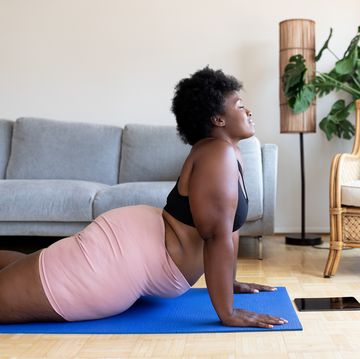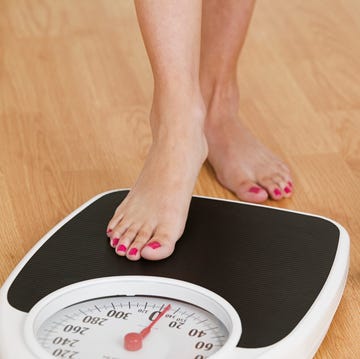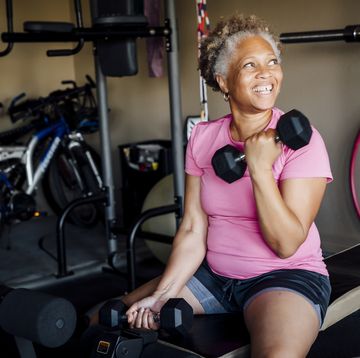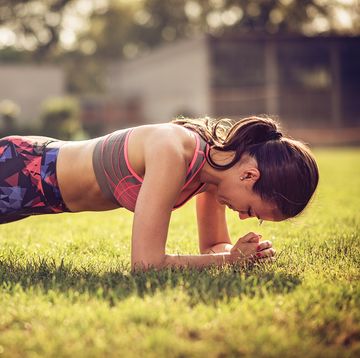When you sit, your body slumps, your metabolism slows, and you…spread. At least, that's what all the experts say. But if you're in a job where you must sit—or you don't want to spend hundreds of dollars on a standing desk—you'll be happy to learn that there are ways to undo the damage, plus boost your calorie burn. (For 10-minute fat-blasting workouts, try Prevention's Fit In 10 DVD.)
First, chairs and couches lead to trouble for the simple reason that they support your body weight. With a chair holding you up, your ankles, knees, and hips stiffen; your muscles weaken; your shoulders round forward; and your back hunches. Even worse, your circulation slows, which depresses your metabolism.
Yikes. Okay, now for some good news: In a new study published in the American Journal of Preventive Medicine, researchers tracked nearly 13,000 women for 12 years to find out how much health damage sitting could do over the long term. Yes, years spent on the couch or hunched over a desk was linked to a greater risk of weight gain, heart disease, and an earlier demise—but only for women who sat still. When the researchers separated the women into three groups—low fidgeting, moderate fidgeting, and high fidgeting—they discovered that the most active sitters completely dodged any increased health risks. These women sat as much as 7 hours a day, but by continually tapping their fingers, bouncing their legs, and, the researchers suspect, hopping up frequently, they were able to avoid the health impacts of lounging.
So if you're trapped in a chair, be sure to add some fidgeting and get up to wander around every 20 minutes or so. And try out the six stretches below. They're designed to counter the muscle-weakening, joint-stiffening, and shoulder-hunching effects of spending too much time on your keister.
For best results, combine this routine with these 12 moves for better flexibility.
What to do: Hold each of these static stretches for 30 seconds, and try to do the series in this order, twice a day.
1. Supported Backbend
Why: Bending backward helps improve posture and supports the muscles that stabilize your spine.
How: Stand facing away from a wall, your heels about 1' away from the baseboard. With your arms over your head, elbows bent backward so that your palms are facing the wall, slowly lean back and catch your body weight with your hands. Walk your hands down the wall until you begin to feel a stretch. (You may also need to step farther away from the wall as your back bends.)
Be sure to start slowly; as your back gets stronger, you'll be able to go deeper into the backbend. Place the tip of your tongue on the roof of your mouth, drop your jaw, and breathe in and out through your nostrils as you hold the backbend.
Here's the gentler version of the backbend move:
MORE: 10 Exercises That Burn More Calories Than Running
2. Lunge with Rotation
Why: Build strength in your legs and shoulders while stretching your hips. The twists will also help maintain healthy spinal movement (healthy discs).
How: From a standing position, take a big step forward with your right foot into a lunge, taking care that your right knee does not extend past your toes. Place your hands on either side of your right foot. Now lift your right arm toward the ceiling and turn your gaze upward at the same time. As you exhale, try to go a little deeper into the rotation. Switch sides and repeat.
Here's the gentler example of the lunge with rotation:
The lunge is not as deep as a “runner's lunge,” and the bottom hand touches the knee, not the floor.
MORE:13 Ways To Lower Blood Pressure Naturally
3. Shoulder Opener
Why: Sitting tends to pull our shoulders inward and collapse our chest. This move opens the shoulders and chest.
How: Stand up straight and tall, holding a towel or belt in each hand behind your back. Raise your arms behind you as high as you can without feeling discomfort. Pull your shoulders back and together as you lift the towel. (Try this strength-training routine for strong, sexy shoulders.)
4. Low Cobra with Feet Elevated
Why: Stretch your hip flexors (they get really tight from being bent in a seated position for too long), strengthen the glutes, open the chest and shoulders, and strengthen the lower back. (Try this hip-opening yoga routine.)
How: Lie facedown with your ankles resting on a foam roller or set of yoga blocks. Press your forearms into the floor and pull your shoulders back as you raise your head up and back.
5. Star Reach
Why: This move lengthens the body by stretching the shoulders, chest, mid-back, hips, and ankles, and it's the perfect antidote for chair-tightened joints and muscles.
How: Stand with your legs slightly wider than hip width. Reach your arms high in the sky with palms facing forward. Spread your fingers. Rise high on your tippy-toes. You'll experience an exhilarating stretch from the extension of the ankles, knees, hips, chest, and shoulders.
MORE: Your Simple 3-Day Diet Detox
6. Number 4 Sit
Why: The piriformis, a little muscle in your rear end, atrophies and tightens with prolonged sitting. With a simple stretch you can keep your piriformis active and flexible.
How: While seated, cross your right ankle over your left thigh. Use your right hand to apply a tiny bit of pressure to the inside of your right knee, and then slightly lean forward until you feel a gentle stretch in your right piriformis (on the side of your glute). Hold the stretch there as you inhale. When you exhale, attempt to apply a tad more pressure and lean a half an inch farther forward into the stretch. Continue with each breath. Switch sides and repeat.














